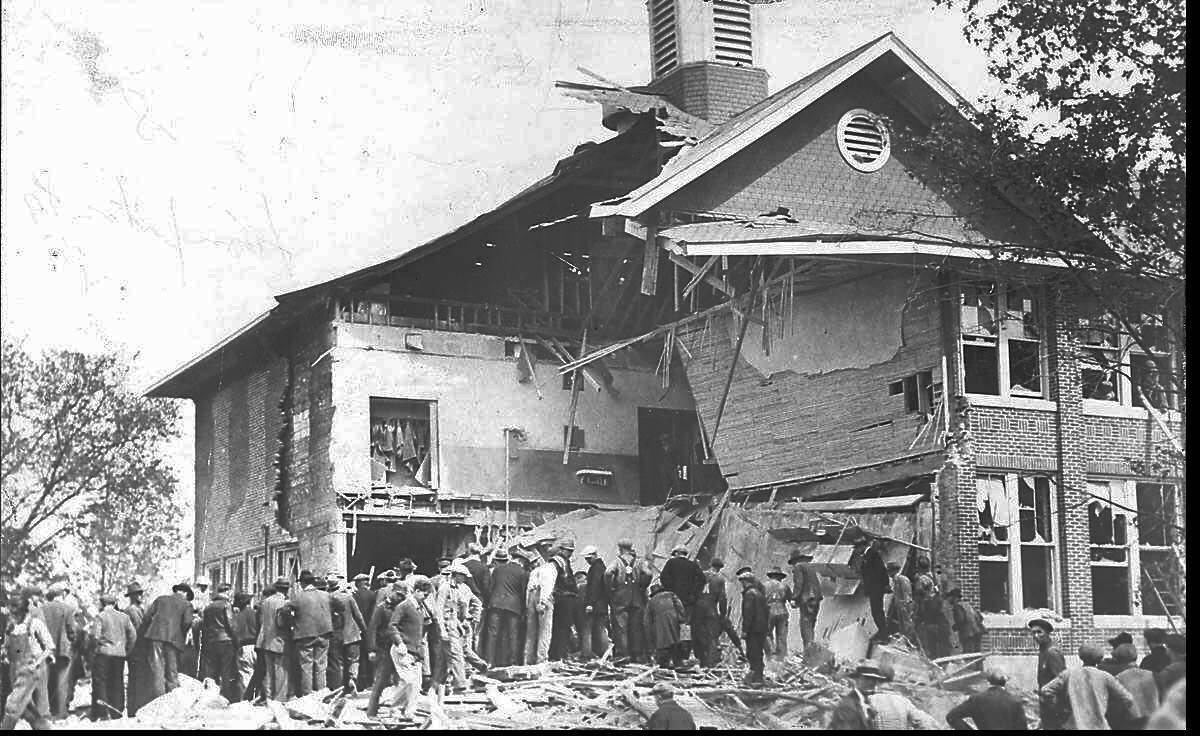
On May 18, 1927, a man named Andrew Kehoe blew up the school in Bath Township, Mich. Most of the 44 killed were children. It remains the deadliest attack on a school in U.S. history. It is also regularly left out of accounts of terrorism in America.
Kehoe, an electrician, had previously worked on the school and had rigged explosives through the buildings in the weeks leading up to the attack. His timer device in one part of the building failed, so children in those rooms survived. In the immediate aftermath of the school explosion, Kehoe set off another bomb in his car, killing himself and several others nearby. Prior to the school explosion, he had murdered his wife and set his own farm on fire. His motive was anger at a foreclosure on his farm, and the taxes levied by the township to pay for the new school.
The story made national headlines immediately, but quickly disappeared. It did not prompt a broader conversation about explosives, or school safety, or mental health, as such an attack today would. Everyone outside Bath Township seemed to forget about it altogether.
Part of the reason Kehoe’s crime was forgotten was that he just did not fit most people’s ideas about terrorists.
In the 1920s, the terrorists whom most Americans feared were anarchists. Newsreels regularly reported anarchist-related bombings and attacks in the U.S. and abroad. Anarchists were scary—but they were also characterized as shady foreigners. When people thought of anarchists, they thought of men like Sacco and Vanzetti, whose final appeal against death sentences had failed a few weeks before Kehoe’s attack. (They would be executed in August.) White men in small towns did not fit the mold.
Get your history fix in one place: sign up for the weekly TIME History newsletter
Today, Kehoe does fit into a defined role for a dangerous individual—we might see him as part of a continuum of angry white men, including the Unabomber and Timothy McVeigh—but in the 1920s, that was not a commonly known archetype. For us, the TV news report with shaken neighbors telling the camera that “he always seemed so quiet” while body bags are wheeled down the driveway behind them has become the stuff of comedy routines. But in 1927, this was not part of most people’s idea of criminality.
Kehoe was also what would now be termed a suicide bomber. This was a new phenomenon at the time, which the media and the public struggled to understand. The New York Times even included Kehoe in their published list of victims – showing the difficulty the press faced in rationalizing the self-destructive terrorist.
There are other reasons the Bath School attack drifted out of public consciousness. Three days after the bombing, Charles Lindbergh crossed the Atlantic, taking over America’s front pages. Kehoe had also closed the case by killing himself. There would be no trial or execution to draw the press back to the story.
For a man without obvious political convictions to commit such an outrage was unfathomable. Had he attacked the bank over his mortgage troubles, he might have earned some public sympathy—as some bank robbers did during the Depression, when banks were widely hated for foreclosures. But to kill members of the public, especially children, seemingly defied explanation.
Then, as now, commentators often reached for a mental-health diagnosis to explain a terrorist attack seemingly disconnected from a political motive. In 1927, however, those reactions were even less sympathetic than modern observers’ might be: the New York Times headline was MANIAC BLOWS UP SCHOOL.
But seeing him as a maniac enabled people to rationalize the incomprehensible. Kehoe’s case didn’t produce hand-wringing op-eds about better support for mental health, as that was not the attitude towards mental illness of the time—but the assumption of insanity was, even then, a way for some to explain a horrific crime. Especially when the perpetrator was someone who didn’t seem like he should be a criminal. He was just crazy, nothing to see here. It is much harder to consider that someone in full control of his faculties could do something so hideous. We reach for the diagnosis of mental illness because it offers a solution. As British sociologist Frank Furedi has argued, this approach stigmatizes the mentally ill. But it serves to comfort the rest of us: we want to see terrorists as crazy, because to see them as rational actors makes them more of a threat.
Today we have our own stereotype of the terrorist: we know him by his religion, political affiliations or social-media history. We worry about lone wolves and “self-radicalization,” but we want terrorists to fit a pattern.
Patterns are predictable—and predictable is preventable. The violent attack by someone who fits no pattern is the most frightening of all. So we prefer to forget men like Andrew Kehoe, because to remember them would be to know it could happen again.
More Must-Reads from TIME
- Cybersecurity Experts Are Sounding the Alarm on DOGE
- Meet the 2025 Women of the Year
- The Harsh Truth About Disability Inclusion
- Why Do More Young Adults Have Cancer?
- Colman Domingo Leads With Radical Love
- How to Get Better at Doing Things Alone
- Michelle Zauner Stares Down the Darkness
Contact us at letters@time.com